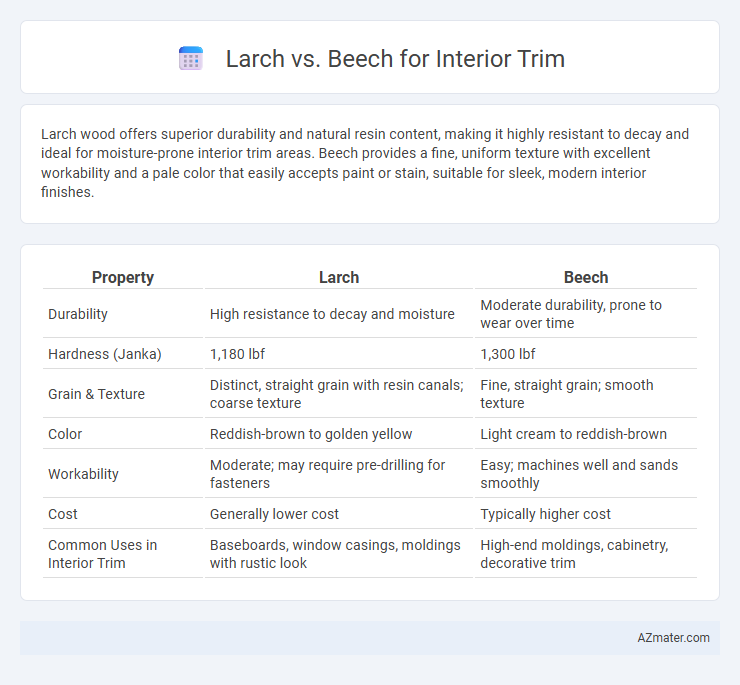Larch wood offers superior durability and natural resin content, making it highly resistant to decay and ideal for moisture-prone interior trim areas. Beech provides a fine, uniform texture with excellent workability and a pale color that easily accepts paint or stain, suitable for sleek, modern interior finishes.
Table of Comparison
| Property | Larch | Beech |
|---|---|---|
| Durability | High resistance to decay and moisture | Moderate durability, prone to wear over time |
| Hardness (Janka) | 1,180 lbf | 1,300 lbf |
| Grain & Texture | Distinct, straight grain with resin canals; coarse texture | Fine, straight grain; smooth texture |
| Color | Reddish-brown to golden yellow | Light cream to reddish-brown |
| Workability | Moderate; may require pre-drilling for fasteners | Easy; machines well and sands smoothly |
| Cost | Generally lower cost | Typically higher cost |
| Common Uses in Interior Trim | Baseboards, window casings, moldings with rustic look | High-end moldings, cabinetry, decorative trim |
Introduction to Larch and Beech Wood
Larch wood, known for its durability and distinctive reddish-brown hue with pronounced grain patterns, offers excellent resistance to rot and moisture, making it ideal for interior trim in humid areas. Beech wood features a fine, tight grain and a pale cream color that deepens to a warm honey tone over time, valued for its smooth finish and ease of staining or painting. Both woods provide strong structural integrity, but larch's natural resistance contrasts with beech's superior workability, influencing their selection for different interior trim applications.
Physical Properties Comparison
Larch wood exhibits exceptional density and durability, with a Janka hardness rating of approximately 1,170 lbf, making it resistant to dents and wear for interior trim. Beech wood, with a hardness rating near 1,300 lbf, offers slightly greater hardness and fine, even grain, resulting in a smooth finish ideal for detailed moldings. Both woods have good dimensional stability, but Larch tends to have higher resin content, affecting its workability and finish absorption compared to the more consistent texture of Beech.
Aesthetic Differences in Grain and Color
Larch wood features a prominent, straight grain with distinctive knots and a warm reddish-brown hue that deepens with age, providing a rustic and dynamic look for interior trim. Beech offers a smooth, fine grain with a pale cream to light reddish-brown color, creating a clean, uniform, and contemporary appearance. Choosing between larch and beech for interior trim depends on the desired aesthetic balance between natural texture and subtle elegance.
Durability and Longevity
Larch wood offers excellent durability with natural resistance to decay and insect damage, making it ideal for interior trim in high-moisture environments. Beech provides a hard, dense surface that resists wear and dents, ensuring long-lasting performance for intricate moldings and trim details. Both woods deliver longevity, but larch's superior resilience in humidity-prone areas often surpasses beech for sustained interior use.
Workability and Ease of Installation
Larch wood offers moderate workability with a coarse texture and high resin content that can dull tools quickly, making precise machining more challenging than beech. Beech excels in ease of installation due to its fine, uniform grain and smooth surface, which allows for clean cuts, minimal splintering, and excellent screw-holding capacity. The superior tool-friendliness and consistent density of beech make it a preferred choice for interior trim requiring exact fits and efficient installation.
Cost and Availability
Larch wood is generally more affordable than Beech, making it a cost-effective choice for interior trim projects. Larch is widely available in regions with abundant coniferous forests, ensuring steady supply and lower market prices. Beech, sourced mainly from European hardwood forests, tends to be pricier and less readily available, impacting both budget and accessibility for interior trim applications.
Environmental Impact and Sustainability
Larch wood, sourced from fast-growing coniferous trees, offers a renewable option for interior trim due to its rapid regrowth and carbon sequestration capabilities. Beech, a hardwood from deciduous forests, is durable but often associated with slower growth rates and potential habitat disruption if not harvested sustainably. Choosing certified larch trims like FSC or PEFC ensures reduced environmental impact and supports sustainable forest management practices.
Best Uses for Each Wood Type
Larch wood is ideal for interior trim in rustic or cabin-style designs due to its warm reddish tones and high durability, making it resistant to wear and moisture in areas like molding and window casings. Beech wood, with its fine grain and smooth texture, is best suited for contemporary or classic interiors where a clean, light finish is desired, commonly used in baseboards and door frames for a polished appearance. Choosing larch enhances natural, rugged aesthetics, while beech provides versatility in staining and painting for refined, elegant trim work.
Maintenance and Care Tips
Larch wood offers natural resistance to decay and requires minimal maintenance, making it ideal for interior trim in areas with variable humidity. Beech, while harder and dense, needs regular sealing and moisture control to prevent warping and discoloration in interior applications. Proper ventilation and periodic cleaning with a damp cloth help preserve the finish and extend the lifespan of both Larch and Beech trims.
Final Recommendation: Choosing Between Larch and Beech
Larch offers exceptional durability and a distinctive grain, making it ideal for rustic or natural interior trim, while beech provides a smooth, uniform texture with excellent workability, suited for a refined, polished finish. Beech's lighter color allows for easy staining and painting, enhancing versatility in design, whereas larch's natural resistance to moisture and decay supports longevity in more demanding environments. For interior trim requiring a blend of aesthetic flexibility and durability, beech is often the preferred choice, but larch excels where natural character and strength are prioritized.

Infographic: Larch vs Beech for Interior Trim
 azmater.com
azmater.com